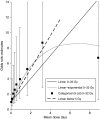Thyroid cancer risk in Belarus among children and adolescents exposed to radioiodine after the Chornobyl accident
- PMID: 21102590
- PMCID: PMC3039791
- DOI: 10.1038/sj.bjc.6605967
Thyroid cancer risk in Belarus among children and adolescents exposed to radioiodine after the Chornobyl accident
Abstract
Background: Previous studies showed an increased risk of thyroid cancer among children and adolescents exposed to radioactive iodines released after the Chornobyl (Chernobyl) accident, but the effects of screening, iodine deficiency, age at exposure and other factors on the dose-response are poorly understood.
Methods: We screened 11 970 individuals in Belarus aged 18 years or younger at the time of the accident who had estimated (131)I thyroid doses based on individual thyroid activity measurements and dosimetric data from questionnaires. The excess odds ratio per gray (EOR/Gy) was modelled using linear and linear-exponential functions.
Results: For thyroid doses <5 Gy, the dose-response was linear (n=85; EOR/Gy=2.15, 95% confidence interval: 0.81-5.47), but at higher doses the excess risk fell. The EOR/Gy was significantly increased among those with prior or screening-detected diffuse goiter, and larger for men than women, and for persons exposed before age 5 than those exposed between 5 and 18 years, although not statistically significant. A somewhat higher EOR/Gy was estimated for validated pre-screening cases.
Conclusion: 10-15 years after the Chornobyl accident, thyroid cancer risk was significantly increased among individuals exposed to fallout as children or adolescents, but the risk appeared to be lower than in other Chornobyl studies and studies of childhood external irradiation.
Figures
References
-
- Astakhova LN, Anspaugh LR, Beebe GW, Bouville A, Drozdovitch VV, Garber V, Gavrilin YI, Khrouch VT, Kuvshinnikov AV, Kuzmenkov YN, Minenko VP, Moschik KV, Nalivko AS, Robbins J, Shemiakina EV, Shinkarev S, Tochitskaya SI, Waclawiw MA (1998) Chernobyl-related thyroid cancer in children of Belarus: a case–control study. Radiat Res 150: 349–356 - PubMed
-
- Boice Jr JD (2005) Radiation-induced thyroid cancer – what's new? J Natl Cancer Inst 97: 703–705 - PubMed
-
- Breslow NE, Day NE (1987) Statistical Methods in Cancer Research. Volume 2 – The Design and Analysis of Cohort Studies. International Agency for Research on Cancer: Lyon - PubMed
-
- Cardis E, Kesminiene A, Ivanov V, Malakhova I, Shibata Y, Khrouch V, Drozdovitch V, Maceika E, Zvonova I, Vlassov O, Bouville A, Goulko G, Hoshi M, Abrosimov A, Anoshko J, Astakhova L, Chekin S, Demidchik E, Galanti R, Ito M, Korobova E, Lushnikov E, Maksioutov M, Masyakin V, Nerovnia A, Parshin V, Parshkov E, Piliptsevich N, Pinchera A, Polyakov S, Shabeka N, Suonio E, Tenet V, Tsyb A, Yamashita S, Williams D (2005) Risk of thyroid cancer after exposure to 131I in childhood. J Natl Cancer Inst 97: 724–732 - PubMed
-
- CTB. Chernobyl Tissue Bank. Available at: http://www.chernobyltissuebank.com/research.html, Accessed 25 May 2010



